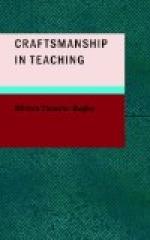We then went to several classrooms, where I saw children realizing themselves, I thought, very effectively. There were three groups at work in each room. One recited to the teacher, another studied at the seats, a third did construction work at the tables. I inquired about the mechanics of this rather elaborate organization, but I was told that mechanics had been eliminated from this school. Mechanical organization of the classroom, it seems, crushes the child’s spontaneity, represses his self-activity, prevents the effective operation of the principle of self-realization. How, then, did these three groups exchange places, for I felt that the doctrine of self-realization would not permit them to remain in the same employment during the entire session. “Oh,” the principal replied, “when they get ready to change, they change, that’s all.”
I saw that a change was coming directly, so I waited to watch it. The group had been working with what I should call a great deal of noise and confusion. All at once this increased tenfold. Pupils jumped over seats, ran into each other in the aisles, scurried and scampered from this place to that, while the teacher stood in the front of the room wildly waving her arms. The performance lasted several minutes. “There’s spontaneity for you,” the principal shouted above the roar of the storm. I acquiesced by a nod of the head,—my lungs, through lack of training, being unequal to the emergency.
We passed to another room. The same group system was in evidence. I noticed pupils who had been working at their seats suddenly put away their books and papers and skip over to the construction table. I asked concerning the nature of the construction work. “We use it,” the principal told me, “as a reward for good work in the book subjects. You see arithmetic is dead and dry. You must give pupils an incentive to master it. We make the privileges of the construction table the incentive.” “What do they make at this table?” I asked. “Whatever their fancy dictates,” he replied. I was a little curious, however, to know how it all come out. I saw one child start to work on a basket, work at it a few minutes, then take up something else, continue a little time, go back to the basket, and finally throw both down for a third object of self-realization. I called the principal’s attention to this phenomenon. “How do you get the beautiful results that you exhibit?” I asked. “For those,” he said, “we just keep the pupils working on one thing until it is finished.” “But,” I objected, “is that consistent with the doctrine of spontaneity?” His answer was lost in the din of a change of groups, and I did not follow the investigation further.




